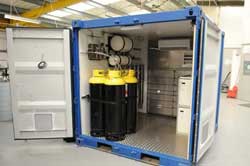
Posted to News on 20th May 2012, 11:39
Fuel cell generator units controlled by NI hardware and software
National Instruments' LabVIEW, CompactRIO and Compact FieldPoint have been used by Diverse Energy to develop the PowerCube, an innovative fuel cell-based alternative to diesel generator sets for applications such as remote mobile phone masts in Africa.

According to a report by the United Nations, mobile phone adoption in Africa rose more than 500 per cent between 2003 and 2008 and can be expected to continue rising exponentially. As such, mobile phones are revolutionising economies in Africa, the world's second largest continent.
However, a mobile phone is of little use without adequate signal coverage. To create a mobile phone signal coverage area, a base station is needed, and this needs a sizeable and reliable electricity supply. The geographical coverage area produced by a single base station is limited, so a country requires a distributed network of base stations to provide adequate mobile phone signal coverage, which requires a distributed and maintainable supply of electricity. The current energy grid in Africa is anything but distributed or reliable, with rural areas suffering the worst conditions. In the relatively few locations where the grid is available, it is often only powered on for a few hours a day and is not dependable during that short time.
Diesel generators have been suggested to solve this problem, but diesel generators are noisy and inefficient when run at part loads. They also require regular maintenance in the form of oil changes every 300 hours. On top of that, they are not environmentally friendly because they emit particulate soot and sulphur into the local atmosphere. Another problem is that diesel generators and their local fuel stores are prime targets for theft, especially in remote and unguarded areas. Of course, there are similar problems with remote power generation elsewhere, and for applications other than mobile phone base stations.
Fuel cell technology
Diverse Energy has developed an alternative power source, known as the PowerCube, that replaces the diesel generator with fuel cell technology; industrial gas is converted into electricity and produces zero local carbon emissions. The industrial gas used in the current product is ammonia, which is widely used and distributed for refrigeration and pharmaceuticals. Ammonia is also used in substantial quantities to manufacture fertilisers for agriculture. To turn ammonia into electricity, ammonia must be tapped from a bulk supply, reformed into hydrogen and nitrogen, then the hydrogen must be separated from the mixed gas stream, and the pure hydrogen stream fed to a fuel cell to produce electricity. In Diverse Energy's PowerCube, NI CompactRIO hardware controls and monitors the entire process.
A very useful by-product of the electricity generation process is pure, deionised water; one PowerCube can produce up to 50 litres per day. In areas where pure, sanitised drinking water is scarce, this is especially helpful.
Rapid development
For all small companies, time to market is a key driver in a business model. If you take too long, you may miss the golden opportunity. The LabVIEW graphical programming environment helps with rapid development and deployment. If Diverse had undertaken the same programming challenges in a text-based language, the engineers would be considerably further behind in the development cycle. LabVIEW helps engineers and scientists make rapid changes to code to test and analyse different operating modes. Conventional programming requires a number of coding specialists to support the development team, which increases headcount and costs. Using LabVIEW, the engineers could develop clever control algorithms to minimise the power consumption of the PowerCube itself, meaning that more of the fuel cell energy could be used by the mobile phone base station.
A 'mark 1' PowerCube that was built first, based on NI Compact FieldPoint. When the engineers realised that CompactRIO could incorporate faster processing as well as global control and communication, they decided to change platforms. The NI CompactRIO platform also incorporates an accessible field-programmable gate array (FPGA) built directly into the backplane of the chassis. Using the LabVIEW graphical interface, the FPGA was programmed to enhance the functionality of the standard I/O, including the production of custom PWM and sine output signals. By embedding this functionality in the FPGA, processing was offloaded from the controller, thereby freeing up the controller to complete other tasks. This also reduced the amount of custom hardware, which had a substantial impact on lowering cost and construction time.
Dr Mike Rendall of Diverse Energy comments: "The LabVIEW graphical programming environment helps with rapid development and deployment. If we had undertaken the same programming challenges in a text-based language, we would not be anywhere near where we are now in the development cycle."
Reusing existing code
Due to the inherent scalability of LabVIEW, as much as 80 per cent of the code was reused code when the switch was made from Compact FieldPoint to CompactRIO, saving a significant amount of development time and cost. It took around eight months to develop and test the mark 1 PowerCube, but only two weeks to move the project over to the CompactRIO platform, including writing a bespoke FPGA image.
Rather than let the Compact FieldPoint systems collect dust, they were repurposed to control three independent test stations to test fuel cell modules. By linking Compact FieldPoint to a database, any updates to the code intended for deployment onto the PowerCube are reflected by the test stations on the next run. In this way, the tests run on the fuel cells remained absolutely relevant as the design of the final product evolved, all with minimal coding time or effort.
There are currently five PowerCubes running in Africa, with a further five in the United Kingdom that are ready to be shipped. LabVIEW and the CompactRIO platform have proven to be excellent for development and field trial use. The ability to easily monitor real-time data and rapidly apply code modifications is an obvious benefit when developing new systems.
Follow the links to find out more about LabVIEW, NI CompactRIO and NI Compact FieldPoint, or use the form at the top of this page to request a callback or more information.
National Instruments Corporation (UK) Ltd
Measurement House, Newbury Business Park
London Road
RG14 2PZ
UNITED KINGDOM
+44 (0)1635 523545





